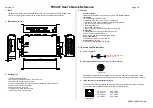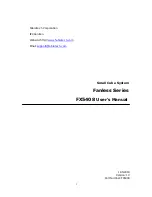
Pr
o
Minent
®
Page 46
Operation of chlorine dioxide system / Operating errors, help, troubleshooting
5.4
Determining chlorine dioxide concentration
First, a sample of water containing chlorine dioxide should be taken from the main water line (see
also section 2.2.5.6). The concentration of chlorine dioxide can be determined easily and reliably
using the DPD method. For this purpose:
the DT 1 manual photometer can be used
The chemicals are in tablet form or are prepared in liquid form and added to a defined volume of
test water. The resulting red coloration is evaluated by measurement in the photometer.
Measurement with DPD 1 tablets detects following substances:
- chlorine dioxide (ClO
2
) and
- free chlorine and chlorine radicals (Cl
2
, HOCl, OCl
-
).
Stable chlorine compounds (e.g. chloramines), chlorite (ClO
-
3
) and chlorine (Cl-) are not detected
by this method.
5.5
Chlorine dioxide metering rate
Since chlorine dioxide systems are used for a variety of purposes, it is not possible to make a
universally acceptable recommendation as to metering rates.
In treating drinking water, the total chlorine dioxide metering rate may not exceed the 0.4 g/m
3
limit. The overall strategy for treating drinking water is a consequence of the metering rate of
chlorine dioxide. Higher metering rates (approx. 1–2 ppm) can be used for industrial water
treatment (e.g. in bottle cleaning machines).
6
Operating errors, help, troubleshooting
6.1
Consequences of operating errors
6.1.1
Incorrect setting of metering pumps
• wrong stroke length (does not agree with gauging):
Consequence:
There is an increased feeding of acid, chlorite or water leading to the production of an unaccept-
able amount of chlorine dioxide.
- An increase in acid raises the excess of acid already existing and there are minor consequences.
- An increase in chlorite can impair the production process and endanger health.
- An increase in water dilutes the concentration of ClO
2
and weakens the effects of disinfection.
- If the amount of feed water is too low (relation of chlorite to water: 1 to 5.5), then there is an
increased concentration of ClO
2
, strengthening disinfection but leading to possible endanger-
ing of the environment and health.
A ClO
2
concentration of 28 g/l or more in the reactor can result in an explosion (through
spontaneous decomposition).
IMPORTANT
If it is necessary to change the stroke length of a metering pump, then
• repeat gauging for all pumps
• set ring initiators correctly (see ch. 2.2.4)
6.1.2
Incorrect setting of flow monitor (ring initiators)
•
Incorrect setting of the ring initiators:
Consequences:
The monitoring function no longer detects a increase in the rate of flow of > 30 % and the system
continues to operate.
- here is an increased feeding of acid, chlorite or a decreased feeding of water leading to the
production of an unacceptable amount of chlorine dioxide (for consequences, see ch. 6.1.1).
IMPORTANT
Set ring initiators correctly (see ch. 2.2.4)
Summary of Contents for Bello Zon CDKa 10000
Page 57: ...ProMinent Page 57...













































